List of preserved British industrial steam locomotives
This article needs additional citations for verification. (January 2021) |
This is the list of preserved British industrial steam locomotives. This list does not contain preserved Fireless locomotives, for a list of preserved Fireless locomotives, visit List of fireless steam locomotives preserved in Britain. Notable locomotives that weren't initially intended for industrial railway service but worked on them (e.g. Furness Railway No. 20, later Barrow Steelworks) will also be included as their rebuilding/resale classified them as industrial-employed steam locomotives.
Use of these locomotives
Private companies like Manning, Wardle & Company were building locomotives as early as 1858 when E.B. Wilson and Company closed.[1] Later located themselves at Boyne Engine Works (1840) in Jack Lane. Within the next few years, Hunslet Engine Company and Hudswell Clarke moved in besides Manning Wardle. One of Manning Wardle's oldest recorded locomotives was Sidlesham, an ex-industrial 0-6-0ST later used on West Sussex Railway. There were also companies as old or older, Kitson & Company, formerly Todd, Kitson and Laird, formed in 1838.
Preserved locomotives
Over one hundred industrial tank engines have survived into preservation, from over ten different manufacturers, ranging from small to big numbers. Most of these locomotives were bought for preservation from industrial service or private use. These locomotives would've been cheap to purchase and maintain and many also formed the beginning of many heritage railways that have expanded from the start to the present.[citation needed]1
Over forty Andrew Barclay tank engines survived into preservation. The oldest survivor being No. 699 Swanscombe built in 1891. These lists might not contain every single locomotive preserved. Many 0-4-0 saddle tanks of small size have been preserved.[3] Many preserved AB&SC locomotives have been preserved in several numbers at the Ribble Steam Railway, Tanfield Railway, Scottish Industrial Railway Centre and Bo’ness and Kinneil Railway. Only notable locomotives with a sizeable amount of information and/or a known recent/current status will be included. Many of these locomotives have been named after where they worked.
| Number & Name | Wheel Arrangement | Image | Current Location | Notes/Status |
|---|---|---|---|---|
| No. 699 Swanscombe | 0-4-0ST | 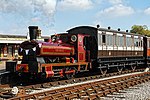
|
Buckinghamshire Railway Centre | Built in 1891. The oldest surviving Andrew Barclay locomotive. Painted in pseudo-Metropolitan Railway Red as Brill No.1. Operational, ticket expires in 2023.[4] |
| No. 776 Firefly | 0-4-0ST | Northampton and Lamport Railway | Built in 1896. Delivered in June 1899 to Mellingriffith and Co. Ltd. Under restoration.[5] | |
| No. 782 Kinlet | 0-6-0ST | 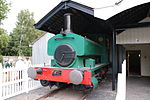
|
Blists Hill Open Air Museum | Built in 1896. Worked at Kinlet Colliery. |
| No. 807 Bon Accord | 0-4-0ST | Royal Deeside Railway | Built in 1897. Ex-Aberdeen Gas Works. Operational following an overhaul in 2019. | |
| No. 880 Glenfield No.1 | 0-4-0CT | 
|
Ribble Steam Railway | Built in 1902. Awaiting restoration to working order. Worked at the Glenfield and Kennedy works in Kilmarnock until the 1960s. Moved to RSR from Chasewater Railway.[6] |
| No. 885 The Barclay | 0-6-0ST | Cambrian Heritage Railways | Built in 1900. Being cosmetically restored. Worked at Eddlewood Colliery until the 1980s when purchased for preservation. | |
| No. 945 Annie | 0-4-0ST | 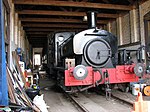
|
Whitwell and Reepham Railway | Built 1904. Under overhaul. Worked for S.J. Clave then Charles Roberts & Co. Ltd. |
| No. 1015 Horden | 0-6-0ST | Tanfield Railway | Built in 1904. Ex-Horden Collieries. Carried the same buffer beam when involved in a collision with a LNER Q6. Undergoing heavy restoration at Marley Hill.[7] Received extensive chassis repairs, boiler sent to workshops of Israel Newton & Sons in Derbyshire in late November 2018. New front tubeplate has been manufactured, soon to be fitted, saddle tank is under repairs at Marley Hill.[8] | |
| No. 1047 Storefield | 0-4-0ST | 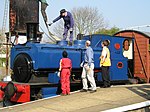
|
East Anglian Railway Museum | Built in 1905. Ex-Cargo Fleet Iron Co. Ltd. Overhaul completed in 2013 and returned to steam. |
| No. 1116 NCB 16 | 0-4-0ST | Scottish Industrial Railway Centre | Built in 1910. Ex-Dalmellington Iron Company. Cosmetically restored and now on display at the Ayshire Railway Preservation Group base at Engineers Shop at Dunaskin. | |
| No. 1147 John Howe | 0-4-0ST | 
|
Ribble Steam Railway | Built in 1908. Ordered by Howe's Plaster Works. Currently on static display.[9] |
| No. 1175 No. 8 Dardanelles | 0-6-0ST | 
|
Polkemmet Country Park | Built in 1909. Named Dardanelles after the WWI campaign in progress when Polkemmet Colliery opened. Cosmetically restored and on display as a war memorial.[10] |
| No. 1193 | 0-4-2ST | Tanfield Railway | Built in 1919. A unique type of locomotive, one of four 0-4-2STs built. To Lothian Coal Co. Ltd. Currently unrestored at Marley Hill Yard.[11] | |
| No. 1219 Caledonia Works | 0-4-0ST | 
|
West Somerset Railway | Built in 1910. Delivered to Stewarts & Lloyds at Clydedale Works. Operational following return to service in 2016. Based at Washford on the West Somerset Railway. |
| No. 1223 Colin MacAndrew | 0-4-0ST | 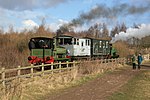
|
Chasewater Railway | Built in 1911. Delivered to Colin McAndrew & Co. Now at the Mountsorrel&Rothley Heritage centre in working condition. |
| No. 1245 | 0-6-0T | 
|
Lakeside and Haverthwaite Railway | Built in 1911. Built for Carron Iron Company. Restored to working order on the Lakeside and Haverthwaite Railway in CR Livery.[12] |
| No. 1260 Forester | 0-4-0ST | Pontypool and Blaenavon Railway | Built in 1911. Delivered to Newport Tinplate Co. Ltd. On display at the Big Pit Mining Museum at Blaenavon.[13] | |
| No. 1296 NCB No. 8 | 0-6-0T | Scottish Industrial Railway Centre | Built in 1912. Cab, bunker, tanks and side rods stolen.[14] | |
| No. 1338 NCB No. 17 | 0-6-0T | Llangollen Railway | Built in 1913. Delivered to Dalmellington Iron Co Ltd. Being restored at the Llangollen Railway [15] for use on the Tanfield Railway. | |
| No. 1385 Rosyth | 0-4-0ST | Pontypool and Blaenavon Railway | Built in 1914. Worked at Royal Naval Dockyard at Rosyth. Currently operational.[16] | |
| No. 1398 Lord Fisher | 0-4-0ST | 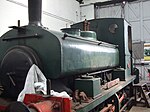
|
Yeovil Railway Centre | Built in 1915. Worked at Royal Naval Airship station near Rochester in Kent. Under overhaul. |
| No. 1458 No. 3 Victoria | 0-6-0ST | 
|
Bo'ness and Kinneil Railway | Built in 1916 for Ministry of Munitions. Donated by NCB to SRPS in 1978. The locomotive was cosmetically restored in 2019.[17] |
| No. 1598 Efficient | 0-4-0ST | 
|
Ribble Steam Railway | Built in 1918. Spent entire working life at McKechnie Brothers’ copper smelting works at Widnes. On display in the Ribble Steam Railway's museum.[18] |
| No. 1605 Ajax | 0-6-0T | 
|
Isle of Wight Steam Railway | Built in 1918. After being built it worked at many locations over a period of years. Awaiting overhaul.[19] |
| No. 1614 NCB No. 19 | 0-4-0ST | Scottish Industrial Railway Centre | Built in 1918 and used at Dalmellington Iron Company. Undergoing a cosmetic restoration. | |
| No. 1619 Toto | 0-4-0ST | Mangapps Railway Museum | Built in 1915 and used by Blaenavon Co. Ltd. Under restoration. | |
| No. 1659 Stanley No. 32 | 0-4-0ST | Tanfield Railway | Built in 1920. Delivered to East Tanfield Colliery. Undergoing overhaul. | |
| No. 1680 Nora No. 5 | 0-4-0ST | 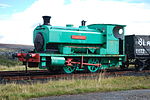
|
Big Pit National Coal Museum | Built in 1920 for the Blaenavon Co. Ltd. Now on display in the Big Pit Mining Museum at Blaenavon. |
| No. 1719 No. 2 Lady Nan | 0-4-0ST | 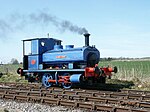
|
East Somerset Railway | Built in 1920. Returned to service in 2017 after boiler ticket expired in the same year. |
| No. 1823 Henry/Harry | 0-4-0ST | 
|
Pontypool and Blaenavon Railway | Built in 1924. Preserved in 1972 at the EBASR. Now stored at Pontypool. |
| No. 1833 Niddrie | 0-6-0ST | 
|
Ribble Steam Railway | Built in 1924. Delivered to Niddrie Collieries. Under restoration.[20] New firebox throatplate being shaped for 1833.[21] |
| No. 1863 | 0-4-0ST | Caledonian Railway (Brechin) | Built in 1926. Worked at Anglo-Scottish Sugar Beet Co. at Cupar. Currently operational. | |
| No. 1865 Alexander | 0-4-0ST | 
|
Ribble Steam Railway | Built in 1926 for Southall Gas Works. Only named in preservation when at Buckinghamshire Railway Centre. Currently on static display.[22] |
| No. 1875 Stanton | 0-4-0CT | 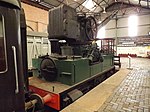
|
Midland Railway – Butterley | Built in 1925. Worked at Stanton and Staveley's Ridding yards. Now on static display at Butterley. |
| No. 1889 | 0-4-0ST | 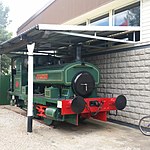
|
Grampian Transport Museum | Built in 1925. Worked at Aberdeen Corporation Gas Works. Now on static display. |
| No. 1890 Forth | 0-4-0ST | 
|
Fife Heritage Railway | Built in 1926. Delivered to the Scottish Gas Board, spent most of life at Granton Gas Works in Edinburgh. Returned to steam in 2016 and operational on the Fife Heritage Railway. |
For a list of preserved Avonside locomotives, see List of preserved Avonside locomotives
W.G. Bagnall locomotive survive in great numbers, near those of Hudswell Clarke, Avonside, Andrew Barclay and Peckett & Sons numbers.[citation needed]
| Number & Name | Wheel Arrangement | Image | Current Location | Notes/Status |
|---|---|---|---|---|
Only one British Dübs locomotive survives in the form of a 0-4-0 crane tank. [citation needed]
| Number & Name | Wheel Arrangement | Image | Current Location | Notes/Status |
|---|---|---|---|---|
| No. 4101 'Dubs' | 0-4-0CT | 
|
Foxfield Railway | Built in 1901. Operational as of 2018. |
Out of all industrial Kitson & Co designs, one of their locomotive constructions were their long-boiler pannier tank locomotives built in the 1880s, originally a Stephenson design, with some working at Barrow Steel and two long boiler locomotives are believed to have worked at Dowlais Ironworks in Wales as No. 34 'Lord Wimbourne',[24][25] one of which, No. 5 of 1883, survives today. Many other industrial Kitson locomotives survive, another well-known one being Lambton Railway 0-6-2T No. 29 of 1904.
| Number & Name | Wheel Arrangement | Image | Current Location | Notes/Status |
|---|---|---|---|---|
| No. 2509 | 0-6-0PT | 
|
North Tyneside Steam Railway | Built in 1883. A very common Kitson design, and a very common (long boiler) design in general. Delivered to Consett Iron Company in 1872. It lasted in industrial service until 1972. Overhaul is now considered, depending on costs. |
| No. 29 | 0-6-2T | 
|
North Yorkshire Moors Railway | Built in 1904. Ex-Lambton, Hetton & Joicey Collieries. Under repairs. Very similar in design to the Hull and Barnsley Railway class F1 and Lancashire, Derbyshire and East Coast Railway class A. |
| Austin No. 1 | 0-6-0ST | 
|
Llangollen Railway | Built in 1932. Built for Austin Motor Company. Currently under overhaul at Llangollen Line, based at Lavender Line. |
| 44 Conway | 0-6-0ST | Locomotion, Shildon | Built in 1933 to a Manning Wardle design after Kitson & Co acquired all drawings and plans after closure in 1926. This Manning Wardle design dates from 1917. Worked for Stewarts & Lloyds Ltd. Being cosmetically restored at Shildon. | |
| 45 Colwyn | 0-6-0ST | Northampton & Lamport Railway | Built in 1933 to a Manning Wardle design after Kitson & Co acquired all drawings and plans after closure in 1926. This Manning Wardle design dates from 1917. Worked for Stewarts & Lloyds Ltd. Under restoration at the Northampton & Lamport Railway. | |
| 47 Carnarvon | 0-6-0ST | 
|
South Devon Railway | Built in 1934 to a Manning Wardle design. Worked for Stewarts & Lloyds Ltd. Currently under overhaul.[26] |
| Number & Name | Wheel Arrangement | Image | Current Location | Notes/Status |
|---|---|---|---|---|
| 641 Sharpthorn | 0-6-0ST | 
|
Bluebell Railway | Built in 1877. Hired by Joseph Firbank for the construction of the Lewes and East Grinstead Railway. Became property of Samuel Williams & Sons in 1888 until 1982. Moved to the Bluebell Line in 1981 and has remained there since. Due to its maximum pulling capacity being very low, no proper consideration has gone into her potential restoration yet. |
| 865 RAF No. 111 Aldwyth | 0-6-0ST | Leeds Industrial Museum | Built in 1882 for Lucas-Aird and Perry Co. Later sold to Air Ministry to work at RAF Kenley in Surrey, later moved to MoW depot at RAF Kidbrooke. Now on static display. | |
| 1207 The Welshman | 0-6-0ST | 
|
Foxfield Railway | Built in 1890 for Llay Hall Colliery. Rare long-boiler locomotive, of which only two were built, 1207 was later rebuilt by its makers in 1908. On loan to the Foxfield Railway for storage, owned by National Coal Mining Museum |
| 1210 Sir Berkeley | 0-6-0ST | 
|
Middleton Railway | Built in 1891. Used by Logan and Hemingway in the construction of the MSLR (later renamed GCR). Continued to be in used by L&H until liquidation in 1935. Received Sir Berkeley nameplates from a scrapped Manning Wardle locomotive. Underwent complete rebuild/overhaul in the 1950s, in 1957 1210 was replaced by a Hudswell Clarke locomotive when Sir Berkeley was declared redundant. Was kept as a back-up engine and later preserved in 1964 and went to the Keighley and Worth Valley Railway. Later purchased by the Vintage Carriage Trust. Overhaul complete in 2007 and withdrawn in early 2017 for another overhaul to return to service. This has begun and is underway. On loan from the VCT to the Middleton Railway. |
| 1317 Rhiwnant | 0-6-0ST | Private Site/destined for Spa Valley Railway | Built in 1891. Used by the Birmingham Corporation. Used in the construction of the Elan Valley Railway. Sold to Stewarts and Lloyds in 1912. Withdrawn in the late 1960s and sold for preservation to the Nottinghamshire Transport Centre at Ruddington. Moved to a private site in Kent, although believed to have moved to Portland for restoration to begin.[27] |
Locomotives sold into industrial use
| Number & Name | Railway & Class | Image | Current Location | Notes/Status |
|---|---|---|---|---|
| No. 20 | Furness Railway Class A5 0-4-0 | 
|
Ribble Steam Railway | Built in 1863 by Sharp, Stewart & Company. Withdrawn in 1870 and sold to Barrow Hematite Steel Company as BHSC No. 7 and was converted to an 0-4-0ST. Rebuilt with a new boiler in 1915 and re-wheeled 1950. Withdrawn from industrial use in 1960 and placed at George Hatswell Special School in Barrow until moved to Walney Island. It was purchased privately in 1983 and relocated to Steamtown Railway Museum. After restoration began, one of the owners' deaths it was sold to the Furness Railway Trust in 1990. On 24 August 1996, the Heritage Lottery Fund awarded the FRT £97,000 to the restoration of No. 20 to its original FR tender locomotive condition. It passed its boiler examination in January 1999 and was launched into service on the 20 April 1999. It was withdrawn from service in July 2018 for an overhaul which began in October 2018.[28] |
| No. 25 | Furness Railway Class A5 0-4-0ST | Ribble Steam Railway | Built in 1865 by Sharp, Stewart & Company. Withdrawn in 1870 and sold to Barrow Hematite Steel Company as BHSC No. 17 and was converted to an 0-4-0ST. Withdrawn from industrial use in 1960 and placed at Stone Cross Special School until 1980 and purchased privately in 1983 and relocated to Steamtown Railway Museum. No. 25 was put up for sale in 2011. It was then donated to the Furness Railway Trust in May 2018. The locomotive will be rebuilt as an 0-4-0 Saddle Tank. Frames arrived at Ribble Steam Railway in November 2018 but restoration will not start until No. 20's overhaul has been completed.[29][30] | |
| No. 110 Burgundy | London, Brighton & South Coast Railway Class E1 0-6-0T | 
|
Isle of Wight Steam Railway | Built in 1877 at Brighton Works. Renumbered B110 by the SR in 1923. Withdrawn from service in 1927 and sold to Cannock and Rugeley Colliery Company and the boiler replaced with a WG Bagnall boiler. It was renumbered CRC No. 9 by using an inverted No. 6 number plate from an 1876 locomotive. Withdrawn in 1963 and sold in 1970 and stored at Hednesford until 1970, being moved to the Chasewater Railway before being sold to members of the East Somerset Railway in 1978. Overhaul began in 1986 and returned to service in 1993 but was withdrawn from service in 1997 due to firebox issues. In 2000, ESR members started work on 110 to find the problem and some parts were but progress was slowed. In 2011, 110 was cosmetically restored and painted in a fictitious British Railways black livery and numbered 32110 before being moved to the Isle of Wight Steam Railway. It is undergoing an assessment for a major overhaul and has been given the identity W2 Yarmouth, the name worn by one of the E1s that operated on the original line in 1932.[31] |
| No. 752 | Lancashire & Yorkshire Railway Class 23 0-6-0ST | 
|
Keighley & Worth Valley Railway | Built in 1881 as an 0-6-0 Tender locomotive Class 25. Rebuilt in 1896 at Horwich as an 0-6-0 Saddle Tank Class 23. Renumbered 11456 by the LMS in 1923. It was sold to Blainscough Colliery in 1937. It was then purchased for preservation from the NCB in 1967 by the L&Y Saddletank Fund, later called the L&Y Railway Preservation Society. It was moved from the colliery to the Keighley & Worth Valley Railway in November 1971 and first steamed in May 1972. Significant maintenance was undertaken on 752 to ready it for participation in the Rail 150 Celebrations in May 1980. It was withdrawn from service in 1982 at 101 years old. Restoration work started in July 2016 at the East Lancashire Railway. An agreement between the ELR and the owners mean that No. 752 will operate on the East Lancs primarily and make visits to the Keighley & Worth Valley Railway too. It is appropriate as Class 23s operated at Castleton performing shunting. The locomotive was hoped to be in steam by 2020. In July 2019, the boiler was fitted and the locomotive moved under its own steam in October 2019. It returned to service in February 2020.[32] |
| No. 5 Cecil Raikes | Mersey Railway Class I 0-6-4T | 
|
Museum of Liverpool | Built in 1885 by Beyer, Peacock & Company Withdrawn in 1904 and sold to Shipley Colliery. It was preserved in 1965 after being in storage for a few years at Derby Locomotive Works and was presented to the Museum of Liverpool by the British Railways Board. Currently on display at the Museum of Liverpool.[33] |
| No. 1340 Trojan | Alexandra Dock Railway 0-4-0ST | 
|
Didcot Railway Centre | Built in 1897 by Avonside Engine Company as Works No. 1386. Owned by Messrs Dunn & Shute of Newport Town Dock before purchased by the Alexandra Dock Railway in 1903. Renumbered 1340 by the Great Western Railway in 1923. Withdrawn in 1932 at Cardiff and sold to Netherseal colliery. It was then sold to Alders Paper Mill in Tamworth in 1947. Saved for preservation by John True in 1968 then given to the Great Western Society at Didcot. Restored to steam from 2002 to 2011. It 2016, the locomotive was sent away for a contract overhaul but costs have slowed this effort down and is still under overhaul and not present at Didcot.[34] |
| No. 28 | Taff Vale Railway Class O1 0-6-2T | 
|
Gwili Railway | Built in 1897 at the Taff Vale Railway's West Works. It was the last-Welsh build standard gauge steam locomotive. Renumbered 450 by the GWR in 1922. Withdrawn by the GWR on 30 October 1926 and sold for use on the Woolmer Military Instructional Railway and named Gordon in 1927. It was renumbered WD 205 and 70205 for usage during World War II and was then sold to the National Coal Board for use of the Hetton Colliery line and renumbered 67. Overhauled in 1955 but withdrawn five years later and donated to the British Transport Board before being moved to Caerphilly. Caerphilly closed in 1963 and No. 67 became part of the National Collection. It was restored to service in 1983 and was taken out of service 7 years later. The locomotive was moved to the Dean Forest Railway in 1996 after the Caerphilly Railway closed. 28 was cosmetically restored by 2014. It is currently on static display at the Gwili Railway with a plan to restore the locomotive to steam underway as of October 2019.[35] |
| No. 85 | Taff Vale Railway Class O2 0-6-2T | 
|
Keighley & Worth Valley Railway | Built in 1899 by Neilson, Reid & Compnay as the first member of the class. Renumbered 426 by the GWR in 1922. Withdrawn in 1927 and sold to Lambton, Hetton & Joicey Colliery in 1929. Became NCB No. 52 in 1947. Withdrawn from industrial use in 1968 and sold to the Midland & Great Northern Railway Preservation Society, later sold to the Keighley & Worth Valley Railway in 1970. It was rebuilt from its industrial modifications and returned to service in the 1990s until withdrawn in 2010. No. 85 returned to service in 2016 after an overhaul.[36] |
| No. 26 | Port Talbot Railway 0-6-0ST | 
|
Severn Valley Railway | Built in 1900 by Hudswell Clarke Renumbered 813 in 1922 by the GWR. It was withdrawn in 1933 and sold in 1934 to Robert Stephenson & Company. It was later sold again to Backworth Collieries. It was later passed into the ownership of the National Coal Board and re-numbered NCB 11 in 1950. In 1966, NCB 11 was put on spare engine duties and sold in 1967 to the GWR 813 Preservation Society and was moved to the Severn Valley Railway. Was a static exhibit at the Rail 150 Celebrations in Shildon. It was at the GW150 Exhibition at Didcot in 1984. Restoration had started initially in 1967 after it was preserved but was halted after a lack of general resources. It was steamed again in 1976 but failed again. After another failed attempt to run 813 in 1984, work continued in 1996 that was undertaken by the SVR's Locomotive Department. It returned to service in July 2000, making visits to other heritage lines before being withdrawn in September 2009. It returned to service in August 2016. It is still owned by the GWR 813 Preservation Fund.[37] |
| No. 9 | Glasgow & South Western Railway Class 5 0-6-0T | 
|
Riverside Museum | Built in 1917 by North British Locomotive Company Re-numbered 324 in 1919 by the G&SWR and 16379 by the LMS. It was withdrawn in 1934 and sold to Hatfield Colliery. It was preserved in 1966 at the Museum of Transport, Glasgow. It was moved to the Riverside Museum in 2010.[38] |
| No. 2 | North Staffordshire Railway New L Class 0-6-2T | 
|
Foxfield Railway | Built in 1923 at the North Staffordshire Railway's Stoke Works. Built in the early months of 1923 and soon renumbered 2271 by the LMS. Withdrawn and sold to Manchester Collieries in October 1937. It received the name 'Princess' while working at Walkden Colliery. In 1960, No. 2 was restored to its North Staffordshire livery and put on display at Crewe by British Railways. After this, No. 2 returned to colliery workings until it was preserved in the Staffordshire County Council Museum. It then moved to Chatterley Mining Museum in 1984 and was placed in the NRM's National Collection. After Chatterley closed in 1993, the locomotive moved to the Churnet Valley Railway but after restoration attempts at the time being hopeless, it moved to Shildon in 2004. In April 2016, the National Railway Museum gifted the locomotive to the Foxfield Railway and are currently assessing No. 2 with a hope of returning it to steam in the future.[39] |
| No. 7754 | Great Western Railway 0-6-0PT | 
|
Llangollen Railway | Built in December 1930 by North British Locomotive Company Withdrawn in January 1959 and sold to the National Coal Board, working at Talywain and Mountain Ash collieries. When it was withdrawn from service in 1975, it was the last British mainline-built operating steam locomotive in the UK. The NCB had been persuaded to donate 7754 to the National Museum of Wales, who then placed the locomotive on permanent loan to the Llangollen Railway. It returned to steam in 1994 but 18 months later was withdrawn from service after the angle ring was found to be cracked. The locomotive is now owned by the Llangollen Railway Trust and is currently under overhaul.[40] |
References
- ^ "E. B. Wilson and Co - Graces Guide".
- ^ "Andrew Barclay, Sons and Co - Graces Guide".
- ^ "Andrew Barclay Sons & Company". 29 October 2017.
- ^ "Buckinghamshire Railway Centre Stockbook".
- ^ "Andrew Barclay & Sons 0-4-0ST L776 Firefly". 22 August 2017.
- ^ "Andrew Barclay 880/1902 0-4-0CT Crane 'Glenfield No1' – Ribble Steam Railway".
- ^ "Home".
- ^ Steam Railway No. 488 January 4–31, 2019 page 30
- ^ "Andrew Barclay 1147/1908 'John Howe' – Ribble Steam Railway".
- ^ "Steam Locomotive Information".
- ^ "Home".
- ^ "1245 (Barclay) | the Lakeside & Haverthwaite Railway".
- ^ "Pontypool and Blaenavon Railway".
- ^ "Steam Locomotive Information".
- ^ "Steam Locomotive Information".
- ^ "Pontypool and Blaenavon Railway".
- ^ "No. 3 Lady Victoria – SRPS Steam".
- ^ "Andrew Barclay 1598/1918 'Efficient' – Ribble Steam Railway".
- ^ "Isle of Wight Steam Railway: Barclay 0-6-0T No.W38 'Ajax'". www.iwsteamrailway.co.uk. Archived from the original on 4 February 2015.
- ^ "Andrew Barclay 1833/1924 'Niddrie' – Ribble Steam Railway".
- ^ Steam Railway No. 488 January 4–31, 2019 page 30
- ^ "Andrew Barclay 1865/1926 'Alexander' – Ribble Steam Railway".
- ^ "Kitson and Co - Graces Guide".
- ^ "Dowlais Works Locomotives".
- ^ "Some Long Boilered Locomotives".
- ^ "Steam Locomotive Information".
- ^ "Steam Locomotive Information".
- ^ "Sharp, Stewart & Co Works No 1448 20 0-4-0 Furness Railway". Preserved British Steam Locomotives.
- ^ Steam Railway No. 488 4–31 January 2019 Page 26
- ^ "Sharp, Stewart & Co Works No 1585 Furness Railway No 25 BHSC No. 17 0-4-0ST". Preserved British Steam Locomotives.
- ^ "32110 (LBSCR 110, SR B110 & BR 32110)". Preserved British Steam Locomotives.
- ^ "752 (L&YR 752 & LMS 11456)". Preserved British Steam Locomotives.
- ^ "Cecil Raikes 0-6-4T Mersey Railway". Preserved British Steam Locomotives.
- ^ "1340 Alexandra Dock Railway 0-4-0ST". Preserved British Steam Locomotives.
- ^ "450 (TV28) TVR Class 01 0-6-2T Taff Vale Railway". Preserved British Steam Locomotives.
- ^ "426 (TV85) TVR class 02 0-6-2T". Preserved British Steam Locomotives.
- ^ "813 Port Talbot Railway & Docks Company 0-6-0ST". Preserved British Steam Locomotives.
- ^ "9 0-6-0T Glasgow & South Western Railway Class 5". Preserved British Steam Locomotives.
- ^ "2 0-6-2T North Staffordshire Railway L Class". Preserved British Steam Locomotives.
- ^ "813 Port Talbot Railway & Docks Company 0-6-0ST". Preserved British Steam Locomotives.
